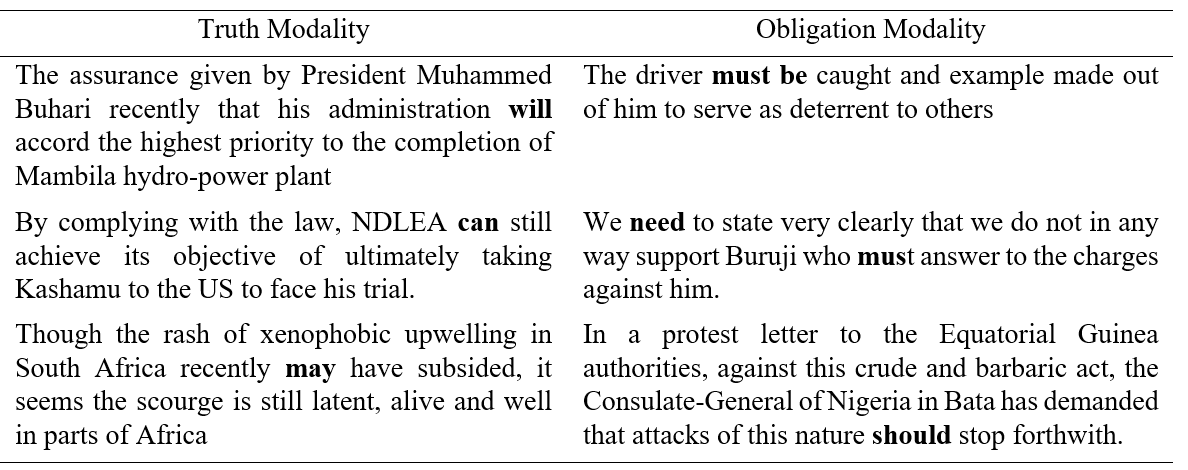A Pragmatic Analysis of Modality in English Academic Texts in Nigeria and Iraq
Abstract
Despite scholars’ attention on the typology of modality as a linguistic phenomenon, yet the use of modality across varieties of English is not well visible in communication-based researches that take semantics, pragmatics and discourse issues as the objects for their investigation. The paper generates its data from six M. A. dissertations from Nigerian University and equal number of the M. A. dissertations from Iraqi University to qualitatively and quantitatively investigate the contextual use of modality within the pragmatic perspective. The data analysis reveals that modality such as usuality, potentiality, necessity, probability and obligation in the dissertations encapsulates interpersonal and authorial voice in which the meaning of a clause is qualified to reflect the writer’s judgment of the likelihood of the proposition it expresses being true. The study findings also show the divergent use of modality to indicate certainty, possibility, probability and evidence and the nature of their illocutionary forces in the academic writings through verb modals and lexically modalized presentations in the MA. Dissertations that form the data of the study.
Downloads
References
Ajami, H. (2016). Arabic language, culture and communication. International Journal of Linguistics and Communication, 4(1), 120–133.
Al-Badri, Z. K. G., & Al-Janabi, S. F. K. (2022). A systemic functional linguistic and critical discourse analysis of a selected speech on COVID-19. Arab World English Journal, 13(2), 314–329. https://doi.org/10.24093/awej/vol13no2.21
Al-Janabi, S. F. K. (2017). Textual architecture of a selected hard news in English: A discourse analysis approach. Arab World English Journal, 8(1), 280–297. https://doi.org/10.24093/awej/vol8no1.20
Al-Janabi, S. F. K., & Al-Marsumi, N. H. R. (2021). Doing stylistic versus critical stylistic: An analysis of “If” by Rudyard Kipling. Arab World English Journal, 12(1), 239–252. https://doi.org/10.24093/awej/vol12no1.16
Al-Marsumi, N. H. R. (2017). The use of tautology in “The Thorn” by William Wordsworth: A stylistic study. Arab World English Journal for Translation & Literary Studies, 1(3), 143–161. https://doi.org/10.24093/awejtls/vol1no3.11
Anand, P., & Hacquard, V. (2013). Epistemics and attitudes. Semantics and Pragmatics, 6(8), 1–59. https://doi.org/10.3765/sp.6.8
Austin, J. L. (1962). How to do things with words. Clavendon Press.
Bally, C. (1942). Syntax of explicit modality. Cahiers Saussure, 2, 3–13.
Bedu, A. M. (2017). Semantico-pragmatic interrelation of editorials and their headlines in English-speaking Nigerian newspapers [Unpublished doctoral dissertation]. Süleyman Demirel University.
Bedu, A. M., & Abba, B. (2017). Pragmatic functions of metadiscourse markers in some selected articles of Hausa newspapers. In A. M. Mu’azu, et al. (Eds.), Language communication and society: Festschrift in honour of Professor Bamidele Rotimi Badejo (Vol. 1, pp. 526–543). Lincom Europa.
Bedu, A. M., & Ismail, H. M. (2022). Mis/disinformation on COVID-19 in social media narratives in Nigeria and Iraq: An exploratory investigation of their linguistic features from pragmatic perspectives. Dilbilim Dergisi - Journal of Linguistics, 39, 89–103. https://doi.org/10.26650/jol.2022.1185466
Bybee, J. L. (1985). Morphology. John Benjamins. https://doi.org/10.1075/tsl.9
Chafe, W. L. (1994). Discourse, consciousness, and time: The flow and displacement of conscious experience in speaking and writing. University of Chicago Press.
Chapin, P. G. (1973). Quasi-modal. Journal of Linguistics, 9(1), 1–9. https://doi.org/10.1017/S0022226700003492
Coates, J. (1983). The semantics of the modal auxiliaries. Croom Helm.
Fairclough, N. (1995). Media discourse. Arnold Publishing.
Fowler, R., Hodge, R., Kress, G., & Trew, T. (1979). Language and control. Routledge and Kegan Paul.
Frawley, W. (1992). Linguistic semantics. Laurence Erlbaum Associates.
Halliday, M. A. K. (1994). An introduction to functional grammar. Edward Arnold.
Halliday, M. A. K., & Hasan, R. (1985). Cohesion in English. Longman.
Halliday, M. A. K., & Hasan, R. (1985). Language, text and context. Derkin University Press.
Hodge, R., & Kress, G. (1979). Language as ideology. Routledge & Kegan Paul.
Hoye, L. (1997). Adverbs and modality in English. Addison Wesley Longman Limited.
Hyland, K. (1998). Hedging in scientific research articles. John Benjamins. https://doi.org/10.1075/pbns.54
Jenkins, J. (2015). Global Englishes (3rd ed.). Routledge. https://doi.org/10.4324/9781315761596
Jespersen, O. (1924). The philosophy of grammar. Norton.
Kachru, B. B. (1985). Standards, codification and sociolinguistic realism: The English language in the outer circle. In R. Quirk & H. G. Widdowson (Eds.), English in the world: Teaching and learning the language and literatures (pp. 11–30). Cambridge University Press.
Kareem, A., & Al-Ahmed, S. (2022). The use of modal verbs in L2 writing of Iraqi undergraduate students. European Journal of Research Development and Sustainability, 3(6), 136–147.
Kearns, K. (2000). Semantics. Macmillan.
Mollin, S. (2006). Euro-English: Assessing variety status. Gunter Narr Verlag.
Morris, C. W. (1938). Foundations of the theory of signs. In O. Neurath, R. Carnap, & C. W. Morris (Eds.), International encyclopedia of unified science (pp. 77–138). University of Chicago Press.
Palmer, F. R. (1974). The English verb. Longman.
Palmer, F. R. (1976). Modality and the English modals. Longman.
Palmer, F. R. (1986). Mood and modality. Cambridge University Press.
Phillipson, R. (1992). Linguistic imperialism. Oxford University Press.
Porter, P. H. (2009). Modality. Oxford University Press.
Quirk, R., Greenbaum, S., Leech, G., & Svartvik, J. (1972). A grammar of contemporary English. Longman.
Quirk, R., Greenbaum, S., Leech, G., & Svartvik, J. (1985). A comprehensive grammar of the English language. Longman Group Limited.
Rasheed, A. (2021). Halliday’s perspective of modality in Iraqi EFL learners’ essays. Journal of Al Anbar University for Language and Literature, 33, 300–321. https://doi.org/10.37654/aujll.2021.171147
Searle, J. R. (1969). Speech acts: An essay in the philosophy of language. Cambridge University Press. https://doi.org/10.1017/CBO9781139173438
Timberlake, A. (1985). Tense, aspect, and mood. In T. Shopen (Ed.), Language typology and syntactic description: Grammatical categories and the lexicon (pp. 202–258). Cambridge University Press.
Trudgill, P., & Hannah, J. (1983). International English: A guide to varieties of standard English. Edwin Arnold.


This work is licensed under a Creative Commons Attribution 4.0 International License.
Copyright for this article is retained by the author(s), with first publication rights granted to the journal.
This is an open-access article distributed under the terms and conditions of the Creative Commons Attribution license (http://creativecommons.org/licenses/by/4.0/).









1.png)









1.png)











